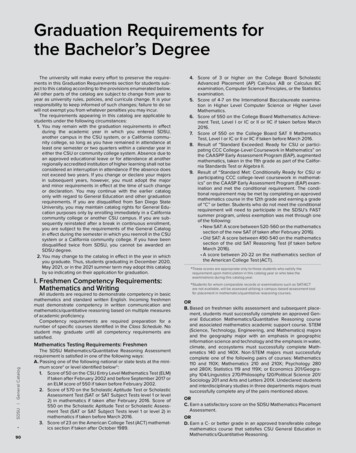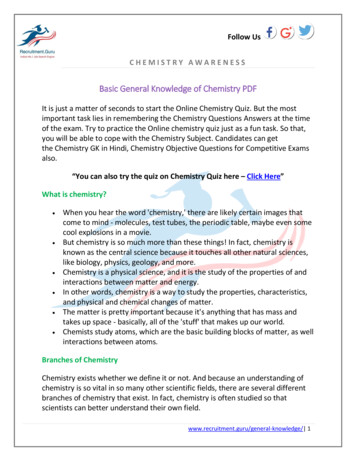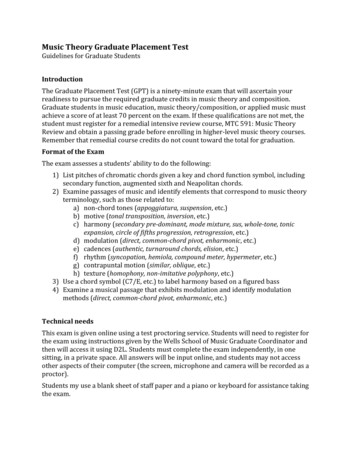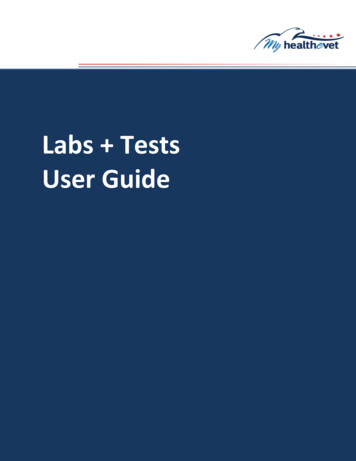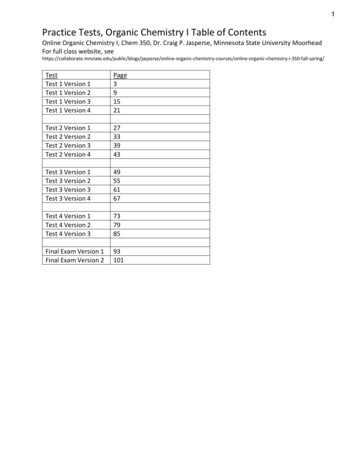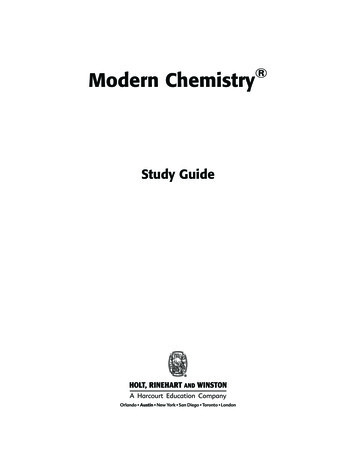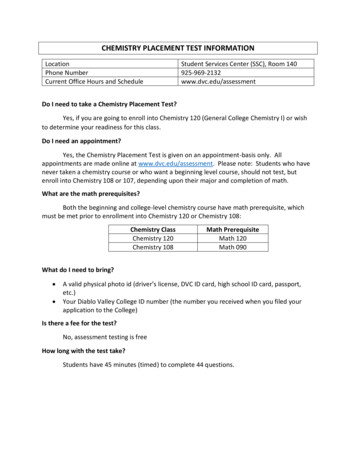
Transcription
CHEMISTRY PLACEMENT TEST INFORMATIONLocationPhone NumberCurrent Office Hours and ScheduleStudent Services Center (SSC), Room 140925-969-2132www.dvc.edu/assessmentDo I need to take a Chemistry Placement Test?Yes, if you are going to enroll into Chemistry 120 (General College Chemistry I) or wishto determine your readiness for this class.Do I need an appointment?Yes, the Chemistry Placement Test is given on an appointment-basis only. Allappointments are made online at www.dvc.edu/assessment. Please note: Students who havenever taken a chemistry course or who want a beginning level course, should not test, butenroll into Chemistry 108 or 107, depending upon their major and completion of math.What are the math prerequisites?Both the beginning and college-level chemistry course have math prerequisite, whichmust be met prior to enrollment into Chemistry 120 or Chemistry 108:Chemistry ClassChemistry 120Chemistry 108Math PrerequisiteMath 120Math 090What do I need to bring? A valid physical photo id (driver’s license, DVC ID card, high school ID card, passport,etc.)Your Diablo Valley College ID number (the number you received when you filed yourapplication to the College)Is there a fee for the test?No, assessment testing is freeHow long with the test take?Students have 45 minutes (timed) to complete 44 questions.
What is the test like?The Chemistry Placement Test is designed to assess the readiness of students who areplanning to enroll in a first year college-level chemistry course (Chemistry 120). It is a paperand-pencil multiple-choice test. The test presumes that students have completed one year ofchemistry in high school or its equivalent. Although not mandatory, it is highly encouraged thatyou review for the test to ensure that you do your very best on it. The Chemistry PlacementTest may be taken only once per semester. On the following pages you will find samplequestions covered by the exam (with answers), and where to find assistance with how they aresolved. Scratch paper, a four-function calculator, and the periodic table will be provided at thetesting session. Since this is a timed test, it is important that you do not linger on any onequestion. If you do not know the answer, skip to the next question—otherwise, you may notcomplete the exam.When do I get the results?Tests are scored by the staff once finished and will be available within approximately 15minutes. The results will be posted to your account by the end of the day.Can I repeat the test?The test can be taken once per semester.What should I do if I test, try to register, and the computer says I have not met theprerequisite for the course?Please call the Assessment Center for assistance. We can help solve the situation sothat you may register for the correct class.Are sample test questions available?For chemistry, please see attached pages.For math, please visit www.dvc.edu/assessmentCHEMISTRY TEST TOPICSThe exam covers nine topic areas of general chemistry:Compounds and Elements (3 questions)States of Matter (2 questions)Reactions (4 questions)Stoichiometry (6 questions)Structure of Matter (8 questions)Periodic Properties (3 questions)Solutions (6 questionsDynamics (2 questionsMathematics (10 questions)
PRACTICE CHEMISTRY PLACEMENT EXAMwith Information on Self-Guided Tutorial1. An atom with an electron configuration of 1s2 2s2 2p3 has how many valence electrons?Khan Academy: Electron Configurations; ChemTutor: Atomic Structurea. 2b. 3c. 4d. 5e. 72. The sublevel of an atom has a total of five orbitals.Khan Academy: Quantum Numbers and Orbitals; ChemTutor: Atomic Structurea. sb. pc. dd. fe. g3. You give a child a balloon, and he goes outside with it to play in the snow. Soon, he returns crying. Whathappened?Khan Academy: Ideal Gas Equation; ChemTutor: Gasesa. The balloon expanded and burst.b. The balloon froze solid.c. The balloon shrank.d. The balloon dissolved.e. The child forgot Charles’ Law.4. What kind of bonding occurs in the compound potassium oxide?Khan Academy: Types of Chemical Bondsa. ionicb. nonpolar covalentc. polar covalent (double bond)d. polar covalent (single bond)e. None of the above5. A gas with a temperature of 21.0oC and a volume of 10.0 L is compressed to 5.00 L. What will be the newtemperature?Khan Academy: Ideal Gas Equation; ChemTutor: Gasesa. 10.5 oCb. 420. oCc. 42.0 oCd. –126 oCe. 315 oC6. Which of the following sublevels does not exist as written?Khan Academy: Quantum Numbers and Orbitalsa. 3fb. 6fc. 2sd. 5de. 8s
7. What is the molecular shape of PH3?Khan Academy: Hybridization and Hybrid Orbitalsa. tetrahedralb. trigonal planarc. bentd. lineare. trigonal pyramidal8. What is the percent by mass concentration of sodium bromide in a solution which contains 50.0 g of sodiumbromide in 200.0 g of water?ChemTutor: Solutionsa. 40.0 %b. 20.0 %c. 25.0 %d. 33.3 %e. 50.0 %9. How many milliliters of 6.00 M HCl solution would be required to prepare 2.00 L of 0.140 M HCl by dilution?ChemTutor: Solutionsa. 420 mLb. 168 mLc. 85.6 mLd. 46.7 mLe. 30.0 mL10. What is the molar concentration of 2000. mL of aqueous solution containing 135 g of glucose, C 6H12O6?ChemTutor: Solutions; Khan Academy: Introduction to the Atoma. 12.15 Mb. 0.750 Mc. 67.5 Md. 0.667 Me. 0.375 M11. What is the formula of copper (II) sulfate pentahydrate?ChemTutor: Compoundsa. Cu2(SO4)2 . 5 H2Ob. Cu2(SO4) . 5 H2Oc. CuSO4 . 6 H2Od. CuSO4 . 5 H2Oe. None of the above12. What is the electron configuration for the nitride ion?Khan Academy: Electron Configurations; ChemTutor: Compoundsa. 1s2 2s2 2p1b. 1s2 2s2 2p3c. 1s2 2s2 2p5d. 1s2 2s2 2p6e. None of the above
13. A tank has a pressure of 30.0 atm at a temperature of 22.0oC. After heating, the temperature rises to 35.0 oC.What is the new pressure?Khan Academy: Ideal Gas Equation; ChemTutor: Gasesa. 54.3 atmb. 31.3 atmc. 28.7 atmd. 47.7 atme. 30.6 atm14. Which pair is immiscible?ChemTutor: Solutions; Khan Academy: Solubilitya. ethanol and waterb. water and octane, C8H18c. isopropyl alcohol and waterd. acetic acid and watere. octane and oil15. How many grams of sodium hydroxide are required to prepare 250.0 mL of a 6.00 M solution?ChemTutor: Solutions; Khan Academy: Introduction to the Atoma. 1.50 gb. 0.0375 gc. 0.600 gd. 3.75 ge. 60.0 g16. 5.60 L of a gas at STP has a mass of 13.0 g. What is the molar mass of the gas?Khan Academy: Ideal Gas Equation; ChemTutor: Gasesa. 33.2 g/molb. 66.4 g/molc. 26.0 g/mold. 52.0 g/mole. none of the above17. What volume of 0.62 M sodium hydroxide is required to neutralize 20.00 mL of 0.391 nitric acid?Word reaction with reactants only. (Students should predict products):Sodium hydroxide nitric acidKhan Academy: Balancing Chemical Equations; ChemTutor: Reactions, Stoichiometrya. 23.6 mLb. 16.9 mLc. 9.03 mLd. 11.8 mLe. none of the above18. How many moles are in 20.0 g of sodium carbonate?Khan Academy: Introduction to the Atom; ChemTutor: Molesa. 1.89 molb. 212 molc. 2.12 x 103 mold. 0.189 mole. 18.9 mol
19. The percent of nitrogen in magnesium nitride isKhan Academy: Molecular Composition; ChemTutor: Moles, Compoundsa. 27.8%b. 36.6%c. 16.1%d. 72.2%e. 63.420. What is the molar concentration of 250. mL of aqueous solution containing 48.8 g of glucose, C6H12O6?ChemTutor: Solutions; Khan Academy: Introduction to the Atoma. 5.12 Mb. 0.923 Mc. 0.271 Md. 1.08 Me. 0.195 M21. How many grams of aluminum metal will react with 0.0500 mole of oxygen gas according to the unbalancedequation given below?Aluminum Oxygen Aluminum OxideKhan Academy: Stoichiometry; ChemTutor: Stoichiometrya. 1.35 gb. 1.01 gc. 4.32 gd. 2.06 ge. 1.80 g22. For the equation given, how many grams of methane will react with 125 g of oxygen?Word reaction with reactants only. (Students should predict products):Methane (CH4) burns in oxygenKhan Academy: Stoichiometry; ChemTutor: Stoichiometrya. 39.1 gb. 19.5 gc. 15.6 gd. 31.3 ge. 62.5 gFor problems 23 - 24, Given the word reaction with reactants only (students should predict products):phosphoric acid reacts with magnesium carbonate23. From the balanced chemical equation the simplest whole number coefficient for the product magnesiumphosphate is:Khan Academy: Balancing Chemical Equations; ChemTutor: Reactionsa. 1b. 2c. 3d. 4e. none of the above
24. If 50.0 g of magnesium carbonate reacts completely with phosphoric acid, the grams of gas produced isKhan Academy: Balancing Chemical Equations; ChemTutor: Reactions, Stoichiometrya. 52.2 gb. 26.1 gc. 13.1 gd. 50.0 ge. 55.0 g25. How many molecules are in 5.8 g of acetone, C3H6O?Khan Academy: Atomic Mass and Moles; ChemTutor: Molesa. 0.10 moleculesb. 6.0 x 1022 moleculesc. 3.5 x 1024 moleculesd. 6.0 x 1023 moleculese. none of the above26. This reaction is an example of which of the following types?aluminum reacts with bromine to produce aluminum bromideChemTutor: Reactionsa. combinationb. single displacementc. decompositiond. gaseouse. precipitation27. What is the simplest whole number coefficient for aluminum bromide in the above reaction (#26)?Khan Academy: Balancing Chemical Equations; ChemTutor: Reactionsa. 1b. 2c. 3d. 4e. none of the above28. How many moles of oxygen are required for the complete reaction of 45g of C 2H4 when it is burned?Khan Academy: Balancing Chemical Equations, Stoichiometry; ChemTutor: Reactions, Stoichiometrya. 1.3 x 102 molb. 0.64 molc. 112.4 mold. 4.8 mole. none of the above29. If 14.0 g of C2H4 is burned and the actual yield of water is 7.84 g, the percent yield in the reaction is:Khan Academy: Balancing Chemical Equations, Stoichiometry; ChemTutor: Reactions, Stoichiometrya. 0.56%b. 43.6%c. 87.1%d. 56.0%e. 82.0%Answers:1d 2c 3c 4a 5d 6a 7e 8b 9d 10e 11d 12d 13b 14b 15e 16d 17e 18d 19a 20d 21e 22d 23a 24b 25b 26a 27b 28d 29b
What is the test like? The Chemistry Placement Test is designed to assess the readiness of students who are planning to enroll in a first year college-level chemistry course (Chemistry 120). It is a paper-and-pencil multiple-choice test. The test presumes that students have completed one year of




